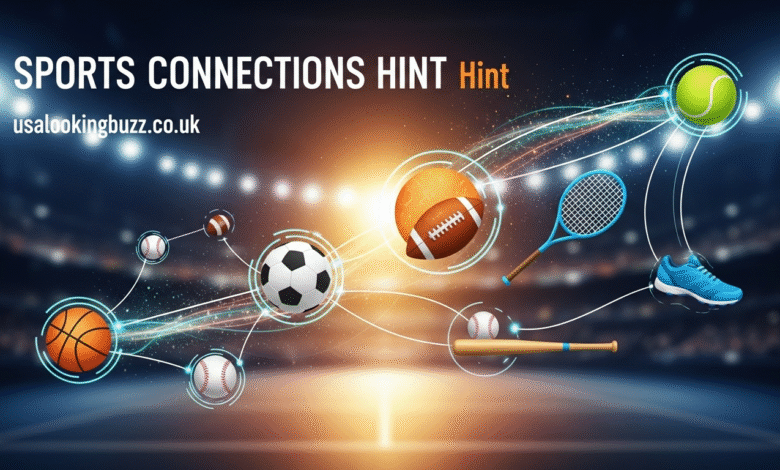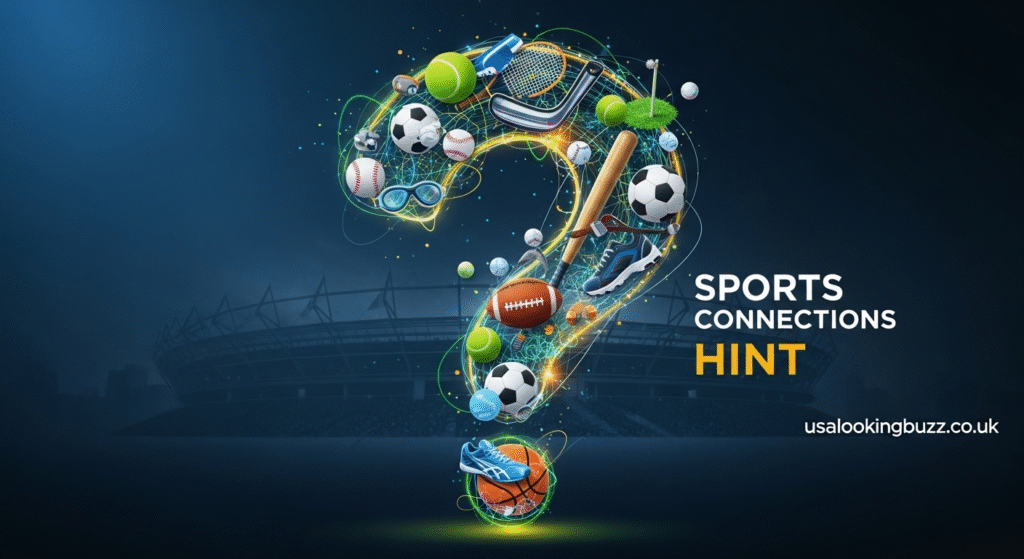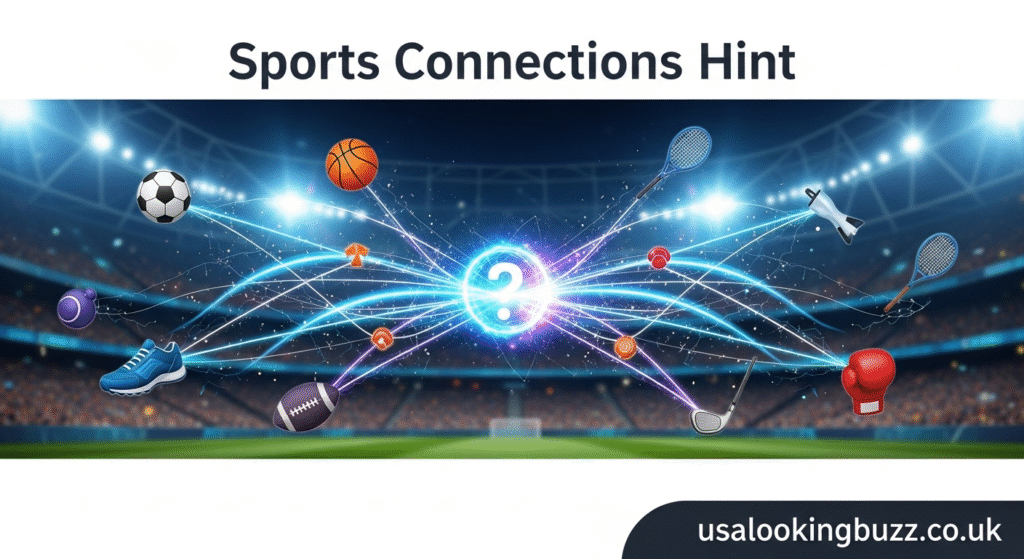Sports Connections Hint: Master Every Puzzle Challenge Fast

Introduction
Ever stared at a Connections puzzle featuring sports categories and felt completely stumped? You’re not alone. The New York Times Connections game has taken the puzzle world by storm, and sports themed puzzles present unique challenges that can frustrate even seasoned players.
Finding the right sports connections hint can mean the difference between victory and defeat. These puzzles require more than just general knowledge. You need to think strategically, recognize patterns, and sometimes make creative leaps that aren’t immediately obvious.
Today, we’re diving deep into everything you need to know about solving sports connections puzzles. Whether you’re a casual player or a competitive puzzle solver, you’ll learn proven strategies that work. We’ll cover common categories, tricky word associations, and expert tips that will transform how you approach these brain teasers. By the end of this guide, you’ll have the tools to tackle any sports connections hint challenge that comes your way.
Understanding the Connections Game Format
Before we jump into sports specific strategies, you need to understand the game’s basic structure. Connections presents you with sixteen words arranged in a grid. Your job is to find four groups of four words that share common themes or connections.
The game uses a color coding system to indicate difficulty levels. Yellow represents the easiest category, followed by green, blue, and finally purple for the trickiest grouping. Sports categories can appear at any difficulty level depending on the specific connection required.
You get only four mistakes before the game ends. This limited error margin makes strategic thinking crucial. Random guessing will likely lead to failure, especially with challenging sports themed puzzles.
Each puzzle resets daily, giving players worldwide the same challenge. This shared experience has created a vibrant community of solvers who discuss strategies and celebrate victories together.
The sports connections hint you need often involves recognizing less obvious relationships. Sometimes the connection isn’t about the sport itself but about wordplay, cultural references, or unexpected associations.
Common Sports Categories You’ll Encounter
Sports connections puzzles draw from a wide range of athletic topics. Familiarizing yourself with common categories gives you a significant advantage when solving.
Team Names and Mascots
One frequent category involves team names from different sports. You might see words like “Giants,” “Cardinals,” “Rangers,” and “Panthers.” The connection is that multiple professional teams across different sports share these names.
These categories can be tricky because the words might seem unrelated at first. You need to think beyond the literal meanings and consider sports franchises.
Mascot based connections work similarly. Words like “Bears,” “Tigers,” “Lions,” and “Wolves” could all represent team mascots across various leagues.

Sports Equipment and Gear
Another common sports connections hint involves equipment used across different activities. Terms like “bat,” “club,” “stick,” and “racket” all represent tools for hitting balls in various sports.
Sometimes the puzzle focuses on protective gear. Words like “helmet,” “pads,” “guard,” and “mask” could form a cohesive group related to safety equipment.
These categories require you to think functionally rather than sport specifically. The connection is about purpose rather than which game uses the item.
Playing Positions
Position names create excellent puzzle categories because many terms appear across multiple sports. “Forward,” “guard,” “center,” and “back” exist in basketball, hockey, soccer, and football with different meanings.
The challenge here is that these words also have non-sports meanings. “Forward” could relate to email or direction. “Guard” might suggest security. You need context clues from surrounding words to identify the sports connection.
Some puzzles use sport specific positions that are less obvious. “Quarterback,” “pitcher,” “goalie,” and “striker” clearly indicate sports but come from different games, requiring you to find their unifying thread.
Sports Terminology and Actions
Verbs and actions common across sports form another frequent category. Words like “serve,” “pass,” “shoot,” and “score” apply to numerous athletic activities.
These puzzles test whether you can see beyond sport specific applications. “Serve” works in tennis, volleyball, and even table tennis. The sports connections hint here is recognizing the shared action despite different contexts.
Timing terms also appear regularly. “Period,” “quarter,” “inning,” and “round” all divide sports competitions into segments, though they belong to different games.
Strategies for Identifying Sports Connections
Success with sports connections puzzles requires systematic thinking. Random guessing wastes your limited mistakes. Instead, use these proven strategies to improve your solving rate.
Start With What You Know Best
Begin by scanning for categories you recognize immediately. If you’re a basketball fan, look for basketball related terms first. This builds confidence and reduces the puzzle’s complexity.
Once you identify a potential group, verify the connection before submitting. Make sure all four words genuinely fit the category. One misplaced word means an incorrect guess and a wasted attempt.
I’ve found that starting with your strongest knowledge area creates momentum. Early success makes the remaining puzzle feel more manageable.
Look for Obvious Patterns First
Yellow categories, the easiest level, often feature straightforward connections. In sports puzzles, this might be four Olympic sports, four ball games, or four water sports.
Scan the grid for words that clearly belong together. If you see “swimming,” “diving,” “rowing,” and “sailing,” that’s likely an aquatic sports category.
Don’t overthink the easiest group. The game designers intend for one category to be relatively simple. Finding it quickly gives you breathing room for tougher connections.
Consider Multiple Meanings
Many sports connections hints involve wordplay or double meanings. A word like “diamond” could refer to baseball’s playing field or the gemstone.
“Court” might relate to basketball, tennis, or the legal system. “Match” works for tennis competitions or lighting fires. These ambiguous terms often appear in purple categories, the most challenging level.
When you see words with multiple meanings, set them aside temporarily. Focus on clearer categories first, then return to these trickier words once you’ve narrowed possibilities.
Think Beyond Individual Sports
The best sports connections hint often involves cross sport thinking. Instead of grouping basketball terms separately from baseball terms, consider what links words from different sports.
Maybe the connection is that they’re all championship names: “Series,” “Bowl,” “Cup,” and “Finals.” Or perhaps they’re all terms that can follow “World”: “Series,” “Cup,” “Championship,” and “Record.”
These meta level connections separate average players from expert solvers. Training yourself to see these patterns takes practice but dramatically improves your success rate.
Use the Process of Elimination
As you correctly identify categories, the remaining words become easier to group. If twelve words are already sorted, the final four must form the last category by default.
This strategy works particularly well when you’re stuck between two possible groupings. Make your best guess on the one you’re more confident about. The remaining words will either confirm or redirect your thinking.
Process of elimination also helps when you’re down to your last guess. If three categories are solved and four words remain, you can submit with confidence even if the connection isn’t entirely clear.
Advanced Tips for Difficult Sports Puzzles
Some sports connections puzzles push even experienced solvers to their limits. These advanced techniques help when standard strategies aren’t enough.
Research Common Puzzle Themes
Connections puzzles often repeat certain types of categories. Familiarizing yourself with these patterns gives you an edge.
For sports puzzles, common themes include:
- Words that can precede or follow “ball” (basket, foot, base, volley)
- Terms used in scoring (goal, point, run, touchdown)
- Venue names (field, court, rink, pitch)
- Championship trophies (Cup, Trophy, Belt, Medal)
Keeping a mental catalog of these recurring themes accelerates your solving process. When you spot potential pattern words, you’ll recognize the connection faster.
Pay Attention to Word Length and Structure
Sometimes the sports connections hint relates to word structure rather than meaning. Four words might all be compound words, or they might all be terms borrowed from other languages.
“Karate,” “judo,” “sumo,” and “kendo” form a group of Japanese martial arts. The connection involves both origin and sport type.
Visual patterns matter too. If four words all start with the same letter or share similar endings, that might be the intended grouping, especially in purple categories.
Consider Historical and Cultural Context
Some sports connections require knowledge beyond the games themselves. Categories might involve:
- Sports featured in ancient Olympics
- Games invented in specific countries
- Activities considered extreme sports
- Competitions added to or removed from Olympic programming
These cultural categories challenge you to think about sports in broader contexts. They’re common in more difficult puzzles designed to test well rounded knowledge.
Don’t Ignore Uncommon Sports
Connections puzzles draw from obscure sports and activities you might not immediately recognize. Terms from cricket, rugby, lacrosse, or curling could appear even if these sports are less popular in your region.
When you encounter unfamiliar words, consider whether they might be sports related terms you don’t know. A quick mental check about whether it could be a position, equipment, or scoring term often helps.
The game occasionally includes sports terms from different English speaking countries. “Pitch” is more common in British English for soccer fields, while Americans say “field.” Being aware of these variations helps.
Common Mistakes to Avoid
Even experienced players fall into predictable traps when solving sports connections puzzles. Avoiding these mistakes improves your success rate significantly.
Forcing Connections That Aren’t There
The biggest error is convincing yourself that four words connect when they actually don’t. You might notice three words that clearly belong together and then force a fourth word to fit.
Always verify that all four words equally share the connection. If one word feels like a stretch, it probably doesn’t belong in that category.
I’ve learned this lesson the hard way multiple times. Taking an extra moment to verify saves you from wasting precious guesses.
Overlooking Simple Answers
Sometimes the sports connections hint is more straightforward than you think. In searching for clever wordplay or obscure references, you might miss obvious groupings.
If four words clearly represent equipment, don’t second guess yourself looking for a more complex connection. The game includes straightforward categories alongside tricky ones.
Balance is key. Don’t overthink easy categories, but don’t underestimate purple difficulty levels either.
Ignoring the Difficulty Progression
Remember that categories range from easy yellow to challenging purple. If you’re stuck between two possible groupings, consider which seems more straightforward.
The simpler, more obvious connection is probably yellow or green. Save your complex theories for blue and purple categories.
This hierarchy helps when you need to make an educated guess. Start with what feels easiest and work toward more sophisticated connections.
Submitting Without Double Checking
Before hitting submit, take three seconds to review your selection. Make sure all four words genuinely fit the category you’ve identified.
This quick verification catches errors that happen when you’re solving quickly. Maybe you accidentally selected a wrong word, or perhaps one doesn’t fit as well as you thought.
Those three seconds often mean the difference between correct and incorrect guesses. Patience beats speed when you only have four mistakes allowed.
Using Community Resources and Hints
The Connections community has grown tremendously, offering resources for players seeking help. Knowing how to use these tools effectively enhances your experience.
Daily Hint Websites and Forums
Several websites publish daily sports connections hints without spoiling the complete answer. These hints provide gentle nudges in the right direction.
Reddit communities dedicated to Connections share strategies and discuss puzzles after solving. Reading these discussions teaches you new pattern recognition techniques.
Twitter and social media feature Connections discussion threads daily. Following experienced players exposes you to different solving approaches.
When to Seek Hints
There’s no shame in checking hints, especially when learning. If you’re completely stuck and frustrated, a small hint can transform confusion into an “aha” moment.
I recommend trying earnestly for at least five minutes before seeking help. This builds your independent solving skills. But if you’re stuck, hints prevent frustration from ruining your enjoyment.
Some players prefer solving without any assistance, while others regularly check hints. Choose the approach that makes the game most enjoyable for you.
Learning From Past Puzzles
Reviewing previous puzzles, especially ones you found challenging, is incredibly educational. Many hint websites archive past games with full explanations.
Studying why certain words grouped together trains your brain to recognize similar patterns. This retrospective learning accelerates improvement more than solving alone.
I make a point to review any puzzle that stumped me. Understanding where my thinking went wrong prevents similar mistakes in future games.
Sports Connections Across Different Difficulty Levels
Understanding how sports categories work at each difficulty level helps you strategize more effectively. The color coding system signals what type of connection to expect.
Yellow Category Sports Connections
Yellow, the easiest level, typically features obvious sports groupings. You might see four Olympic sports, four team sports, or four individual competitions.
These categories rarely involve wordplay or hidden meanings. The connection is usually direct and based on clear categorization.
If you’re new to Connections, start by identifying the yellow category. It builds confidence and reduces the puzzle’s intimidation factor.
Green Category Challenges
Green categories introduce slightly more nuance. A sports connections hint at this level might involve less obvious similarities.
For example, four sports that use nets (basketball, tennis, volleyball, hockey) require recognizing a specific commonality rather than broad categorization.
These puzzles test whether you can move beyond surface level observations to identify shared characteristics.
Blue Category Complexity
Blue categories often involve cross referencing or contextual knowledge. Sports terms might connect through etymology, historical origins, or cultural significance.
Words that can complete a common phrase present another blue level challenge. “World ___” might precede “Series,” “Cup,” “Record,” and “Champion.”
These require creative thinking and the ability to see words in multiple contexts simultaneously.
Purple Category Mastery
Purple, the hardest level, frequently employs wordplay, double meanings, or highly specific knowledge. A sports connections hint here might be extremely subtle.
Perhaps four words are all anagrams of sports terms, or they’re all terms that sound like other words when spoken aloud.
These categories separate casual players from dedicated experts. Don’t feel discouraged if purple stumps you regularly. It’s designed to be exceptionally challenging.
Improving Your Sports Knowledge for Better Solving
Expanding your sports knowledge directly improves your Connections performance. You don’t need to become an expert in every sport, but broadening your familiarity helps tremendously.
Follow Multiple Sports Casually
Even passive exposure to various sports builds the knowledge base you’ll draw from during puzzles. Watching highlights or reading sports news keeps terminology fresh.
You don’t need deep expertise. Simply knowing that curling exists and uses “stones” might be the sports connections hint you need someday.
I started following sports I’d never watched specifically to improve at Connections. This cross training approach works surprisingly well.
Learn International Sports Terms
American solvers should familiarize themselves with cricket, rugby, and football (soccer) terminology. British terms for familiar sports also help.
Similarly, international players benefit from learning American football, baseball, and basketball basics. Connections draws from global sports culture.
This cultural knowledge fills gaps that might otherwise leave you stumped on seemingly simple puzzles.
Study Sports History and Trivia
Understanding how sports evolved, where they originated, and their cultural significance provides context for challenging categories.
Knowing that basketball was invented by James Naismith or that the first Super Bowl was played in 1967 might seem trivial. But these facts connect to puzzle categories more often than you’d expect.
Sports documentaries and trivia shows offer entertaining ways to build this knowledge without formal study.

Technology and Tools for Connection Solvers
Modern technology offers helpful tools for improving your Connections game. While purists prefer solving unaided, these resources serve valuable purposes.
Pattern Recognition Apps
Some apps help train pattern recognition skills through similar puzzle games. Playing these builds the mental muscles you use during Connections.
These aren’t cheats but rather practice tools that strengthen your puzzle solving abilities overall.
Word Association Tools
Online thesauruses and word association websites help you explore connections between terms. If you’re stuck, looking up synonyms or related words can trigger insights.
Use these tools after attempting the puzzle yourself. They work best as learning aids rather than crutches.
Tracking Your Progress
Spreadsheets or apps that track your solving statistics show improvement over time. Monitoring your success rate and identifying which category types challenge you most guides targeted practice.
I keep notes on puzzles that stumped me. Reviewing these patterns helps me recognize similar challenges in future games.
The Social Aspect of Connections Puzzles
Connections has become more than just a game. It’s a social phenomenon that brings puzzle enthusiasts together daily.
Sharing Scores and Strategies
The game generates shareable emoji grids showing your solving pattern without spoiling the answers. Posting these on social media connects you with other players.
Discussing strategies with friends improves everyone’s skills. Different people notice different patterns, and sharing perspectives broadens your approach.
Friendly Competition
Many players compete informally with friends or family. Comparing who solved fastest or with fewest mistakes adds extra motivation.
This friendly competition keeps the game engaging day after day. The social accountability also encourages consistent play.
Community Building
Online communities dedicated to Connections provide support, hints, and camaraderie. These spaces celebrate victories and commiserate over particularly challenging puzzles.
Being part of this community transforms Connections from a solitary activity into a shared experience. The sports connections hint you need might come from a fellow solver’s insight.
Conclusion
Mastering sports connections hints takes practice, patience, and strategic thinking. You’ve now learned the common categories, effective strategies, and advanced techniques that separate successful solvers from frustrated guessers.
Remember to start with what you know best, look for obvious patterns first, and consider multiple meanings when stuck. Avoid common mistakes like forcing connections or overlooking simple answers. Use community resources wisely, and don’t hesitate to expand your sports knowledge beyond familiar territory.
The beauty of Connections lies in that perfect moment when the pattern clicks into place. Every puzzle offers a chance to exercise your brain, learn something new, and experience that satisfying rush of solving a challenge.
What sports connections hint will you discover in tomorrow’s puzzle? Share your favorite solving strategies with fellow players and keep practicing. The more you play, the better you’ll become at spotting those elusive connections that once seemed impossible.
Frequently Asked Questions
What is a sports connections hint? A sports connections hint is a clue or strategy that helps you identify groups of four sports related words in the daily Connections puzzle. These hints might point toward common categories like team names, equipment, positions, or actions that appear across different sports.
How do you solve sports themed Connections puzzles? Start by identifying the easiest category first, usually marked as yellow difficulty. Look for obvious groupings like four Olympic sports or four types of equipment. Consider whether words share functions across different sports rather than belonging to the same sport. Use process of elimination as you solve each category.
What are the most common sports categories in Connections? The most frequent sports categories include team names shared across leagues, equipment terms, playing positions, scoring terminology, and championship names. Categories might also involve sports that share specific characteristics like water sports, racket sports, or combat sports.
Can I get hints for today’s Connections puzzle? Yes, several websites and social media communities provide daily hints without spoiling the complete answer. These resources offer gentle guidance that nudges you toward the right connections while preserving the satisfaction of solving. Reddit and Twitter have active Connections communities that share helpful hints.
What’s the difference between yellow and purple difficulty in sports puzzles? Yellow represents the easiest category with straightforward connections, like four clearly related sports or obvious equipment terms. Purple is the hardest level, often involving wordplay, double meanings, obscure knowledge, or highly creative connections that aren’t immediately apparent even to sports fans.
How can I improve at solving sports Connections puzzles? Expand your knowledge of various sports beyond your favorites. Learn terminology from international sports like cricket or rugby. Study past puzzles to recognize recurring patterns. Practice regularly and review puzzles that stumped you to understand where your thinking went wrong.
Are sports Connections puzzles harder than other themes? Difficulty varies by individual knowledge. Sports puzzles might be easier if you’re an athletics enthusiast but harder if you’re unfamiliar with sports terminology. The game designers balance puzzles to challenge players with diverse backgrounds, so every theme presents unique obstacles.
What should I do if I’m completely stuck on a sports puzzle? Take a break and return with fresh eyes. Try eliminating words you’re certain don’t belong together. Look for less obvious connections like words that can precede or follow the same term. If still stuck, check hint websites for gentle guidance without full spoilers.
Do I need to be a sports expert to solve these puzzles? No, you don’t need expert level sports knowledge. Many sports connections involve general terminology or patterns recognizable to casual fans. The game tests pattern recognition and creative thinking as much as specific sports knowledge. Basic familiarity with major sports usually suffices.
How many mistakes am I allowed in Connections? You get four mistakes total before the game ends. This limited margin makes strategic thinking essential. Verify connections carefully before submitting, and save your guesses for when you’re reasonably confident rather than making random attempts.
Also Read Usalookingbuzz.co.uk



